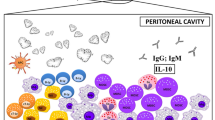Abstract
Cytokine and antibody production was investigated during the course of resolution of primary infection in Plasmodium yoelii 17XL-infected BALB/c mice treated with a mixture of febrifugine and isofebrifugine. The infected mice in an untreated control group showed a progressively increasing parasitemia, leading to mouse death. In contrast, infected mice given the mixture orally showed low parasitemia levels during administration. Following a transient increase in parasitemia in the bloodstream of the treated mice, no parasites could be detected by microscopic examination. Analysis of cytokines in plasma showed that the plasma IFN-γ levels elevated significantly within the first week of infection in both groups. Furthermore, on day 20 the plasma IFN-γ and IL-4 levels elevated significantly in the treated mice and the production of both cytokines was sustained until at least day 40. The production of both cytokines in the treated mice was coincident with a decrease in parasitemia. The production of parasite-specific antibodies in the course of P. yoelii 17XL infection was also monitored. In the drug-treated mice, the titers of parasite-specific IgG1, IgG2a, IgG2b and IgG3 elevated significantly from day 20; and the production of parasite-specific antibodies was coincident with a decrease in parasite numbers in the bloodstream.





Similar content being viewed by others
References
Goldman IF, Qari SH, Skinner J, Oliveira S, Nascimento JM, Povoa MM, Collins WE, Lal AA (1992) Use of glass beads and CF11 cellulose for removal of leukocytes from malaria-infected human blood in field settings. Mem Inst Oswaldo Cruz 87:583–587
Herrera MA, Rosero F, Herrera S, Caspers P, Rotmann D, Sinigaglia F, Certa U (1992) Protection against malaria in Aotus monkeys immunized with a recombinant blood-stage antigen fused to a universal T-cell epitope: correlation of serum gamma interferon levels with protection. Infect Immun 60:154–158
Ho M, Webster HK (1989) Immunology of human malaria. A cellular perspective. Parasite Immunol 11:105–116
Ishih A, Ikeya C, Yanoh M, Takezoe H, Miyase T, Terada M (2001) A potent antimalarial activity of Hydrangea macrophylla var. Otaksa leaf extract against Plasmodium yoelii 17XL in mice. Parasitol Int 50:33–39
Jayawardena AN, Targett GAT, Leuchars E, Carter RL, Doenhoff MJ, Davis AJS (1975) T-cell activation in murine malaria. Nature 258:149–151
Kobayashi F, Morii T, Matsui T, Fujino T, Watanabe Y, Weidanz WP, Tsuji M (1996) Production of interleukin 10 during malaria caused by lethal and nonlethal variants of Plasmodium yoelii yoelii. Parasitol Res 82:385–391
Langhorne J, Evans CB, Asofsky R, Taylor DW (1984) Immunoglobulin isotype distribution of malaria-specific antibodies producing during infection with Plasmodium chabaudi adami and Plasmodium yoelii. Cell Immunol 87:452-461
Langhorne J, Gillard S, Simon B, Slade S, Eichmann K (1989) Frequencies of CD4+ T cells reactive with Plasmodium chabaudi chabaudi: distinct response kinetics for cells with Th1 and Th2 characteristics during infection. Int Immunol 1:416–424
Maheshwari RK, Czarniecki CW, Dutta GP, Puri SK, Dhawan BN, Friedman RM (1986) Recombinant human gamma interferon inhibits simian malaria. Infect Immun 53:628–630
Majarian WR, Daly TM, Weidanz WP, Long CA (1984) Passive immunization against murine malaria with an IgG3 monoclonal antibody. J Immunol 132: 3131–3137
Matsumoto S, Yukitake H, Kanbara H, Yamada H, Kitamura A, Yamada T (2001) Mycobacterium bovis bacillus calmette-guerin induces protective immunity against infection by Plasmodium yoelii at blood-stage depending on shifting immunity toward Th1 type and inducing protective IgG2a after the parasite infection. Vaccine 19:779–787
Ockenhouse CF, Schulman S, Shear HL (1984) Induction of crisis forms in the human parasite Plasmodium falciparum by γ-interferon activated, monocyte-derived macrophages. J Immunol 133:1601–1608
Saitoh H, Miyase T, Ueno A (1994) Reinioses A-J, oligosaccharide multi-esters from the roots of Polygala reinii Fr. et Sav. Chem Pharm Bull 42:1879–1885
Shear HL, Srinivasan R, Nolan T, Ng C (1989) Role of IFN-γ in lethal and nonlethal malaria in susceptible and resistant murine hosts. J Immunol 143:2038–2044
Shear HL, Ng C, Zhao Y (1990) Cytokine production in lethal and non-lethal murine malaria. Immunol Lett 25:123–128
Smith EC, Taylor-Robinson AW (2002) Parasite-specific immunoglobulin isotypes during lethal and non-lethal murine malaria infections. Parasitol Res 89:26–33
Souza JB de, Playfair JHL (1995) A novel adjuvant for use with a blood-stage malaria vaccine. Vaccine 13:1316–1319
Souza JB de, Williamson KT, Otani T, Playfair JHL (1997) Early gamma interferon responses in lethal and non lethal murine blood-stage malaria. Infect Immun 65: 1593–1598
Stevenson MM (1989) Genetic control of host resistance to malaria. In: Stevenson MM (ed) Malaria: host responses to infection. CRC Press, Boca Raton, Fla., pp 147–161
Stevenson MM, Tam M-F (1993) Differential induction of helper T cell subsets during blood-stage Plasmodium chabaudi AS infection in resistant and susceptible mice. Clin Exp Immunol 92:77–83
Weid T von der, Langhorne J (1993) The role of cytokines produced in the immune response to the erythrocytic stages of mouse malarias. Immunobiology 89:397-418
Weidanz WP, Long CA (1988) The role of T cells in immunity to malaria. Prog Allergy 41:215–252
White WI, Evans BE, Taylor DW (1991) Antimalarial antibodies of the immunoglobulin G2a isotype modulate parasitemias in mice infected with Plasmodium yoelii. Infect Immun 59:3547–3554
Yoshida A, Koide Y, Uchijima M, Yoshida TO (1995) Dissection of strain difference in acquired protective immunity against Mycobacterium bovis Calmette–Guerin bacillus (BCG). J Immunol 155:2057–2066
Author information
Authors and Affiliations
Corresponding author
Rights and permissions
About this article
Cite this article
Ishih, A., Nagata, T., Kobayashi, F. et al. Cytokine and antibody production during the course of resolution in Plasmodium yoelii 17XL-infected BALB/c mice treated with febrifugine and isofebrifugine mixture from leaves of Hydrangea macrophylla var. Otaksa. Parasitol Res 94, 176–182 (2004). https://doi.org/10.1007/s00436-004-1187-4
Received:
Accepted:
Published:
Issue Date:
DOI: https://doi.org/10.1007/s00436-004-1187-4




